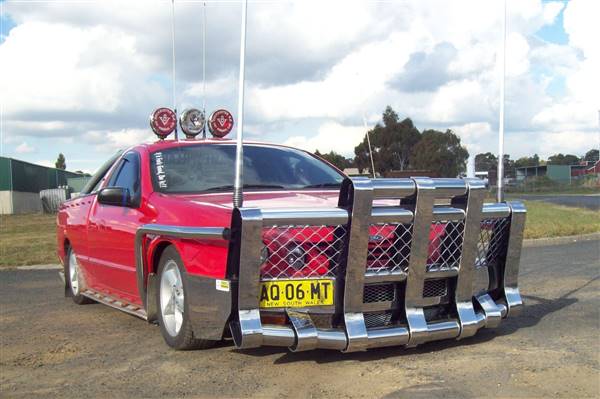
Nudge bars or bull bars were first developed in Australia to protect cars against the larger mammals and birds that roam the land, like kangaroos and emus. The example above, from bullbarsaustrlia.com.au (which has recently been made illegal), shows how extreme they got – like they were protecting your car against some kind of zombie apocalypse. While you wouldn’t get away with one like that, it is not illegal for vehicles to be fitted with bull bars in the UK. As long as the bull bars do not cause an increased risk to “passengers, pedestrians and other road users”, they are allowed.
The problem with older bull bars is that they were rigid and negated the vehicle’s own crumple zones and crash protection. They can inflict much worse damage on vulnerable road users like motorcyclists, cyclists and pedestrians. Research from crashes in the late 1990s showed that pedestrian deaths could be reduced by 6% and serious injuries reduced by 21% if the vehicles involved had not had bull bars.
Bull bars have many advantages for certain segments of our driving population: for farmers, they prevent light panel damage from livestock, fence posts and so on, and for off-road enthusiasts they can protect the lights and bodywork against damage from tree branches, and provide mounting points for an aerial, additional lights or a winch.
Since 25 May 2007 bull bars fitted must be EU compliant. Most manufacturers have changed their terminology and call them frontal protection bars, A bars or front bars. The EU compliance ensures that the bull bars have some give for pedestrians and that their sole purpose is to help avoid minor panel damage because the driver will feel the obstruction before the obstruction reaches parts of the vehicle that can break, like the radiator or lights.
Cleaning bull bars
Bull bars tend to be made of a combination of steel or aluminium tubing and plastic (usually polycarbonate or polyethylene). You can clean them using water and a car wash product; they don’t need a car wax like the paintwork. Polishes designed for metals can be used. If the plastic components begin to fade, there are products to renovate them.
Crash characteristics of bull bars
Modern bull bars must have a minimum protection level for pedestrians and have been specifically created for the type of vehicle it’s being fitted to so that it doesn’t prevent the air bags from deploying in a crash. In fact, newer plastic ones can actually provide the same amount of pedestrian protection than not having a bull bar, in some cases.
Fitting an illegal bull bar comes with some serious penalties, especially if you cause injury or death in an accident because of the bull bar. Your insurance company might not accept your claim because you will have an illegal accessory fitted.
If you want a bull bar for your work pickup or van then always use a reputable supplier and ensure that any bull bar you buy comes with an EU compliance certificate. Approved devices carry an indelible ‘e’ mark, e.g. e1 01 1471.
You can read the full EU bull bar directive here, and wade through the legislation here: EU Bull Bars Legislation. The legislation contains all the specifics about the maximum angles, dimensions and other measurements of bull bars. Note: the regulations only apply to front-mounted bull bars, not rear-mounted bars.
